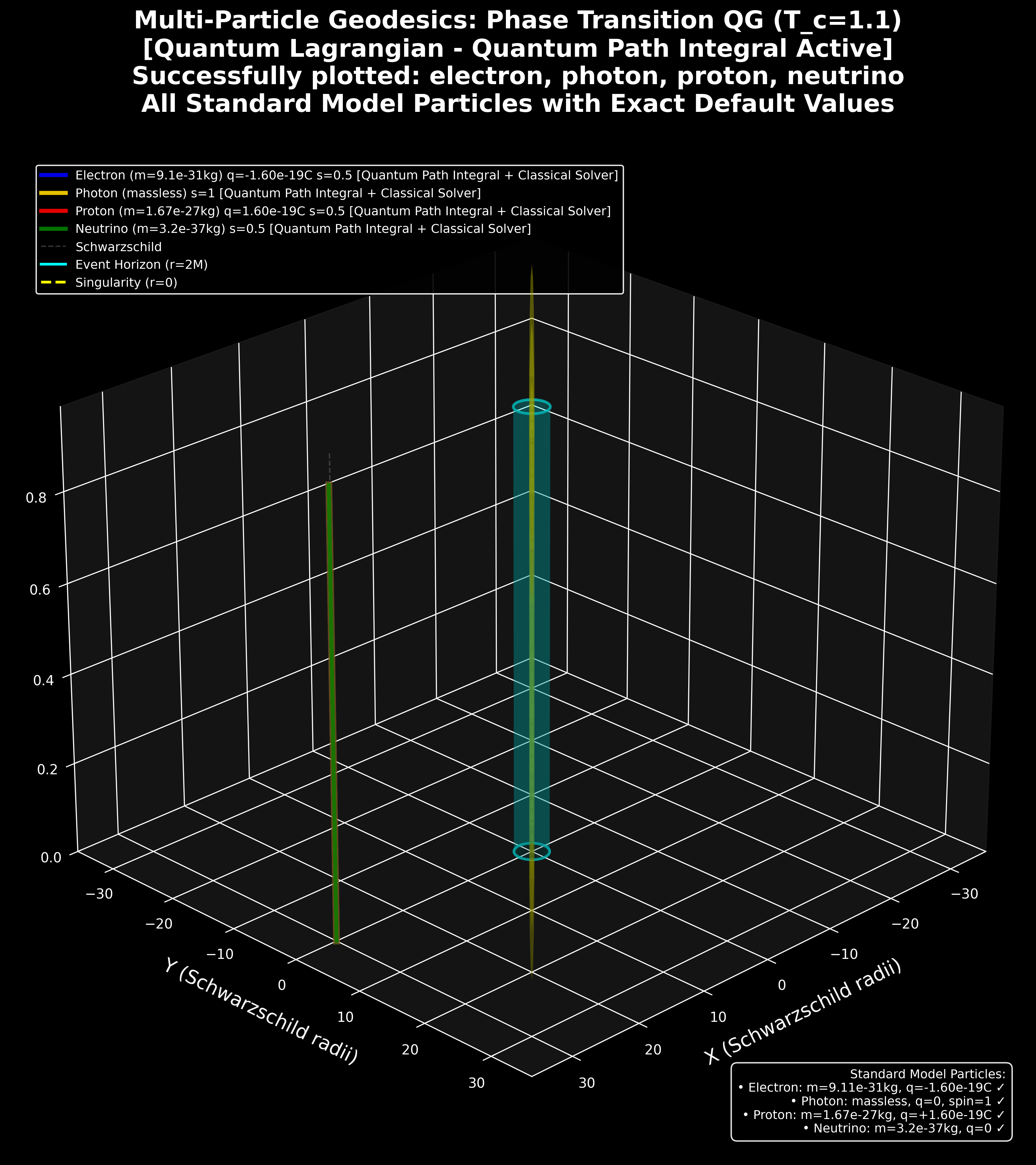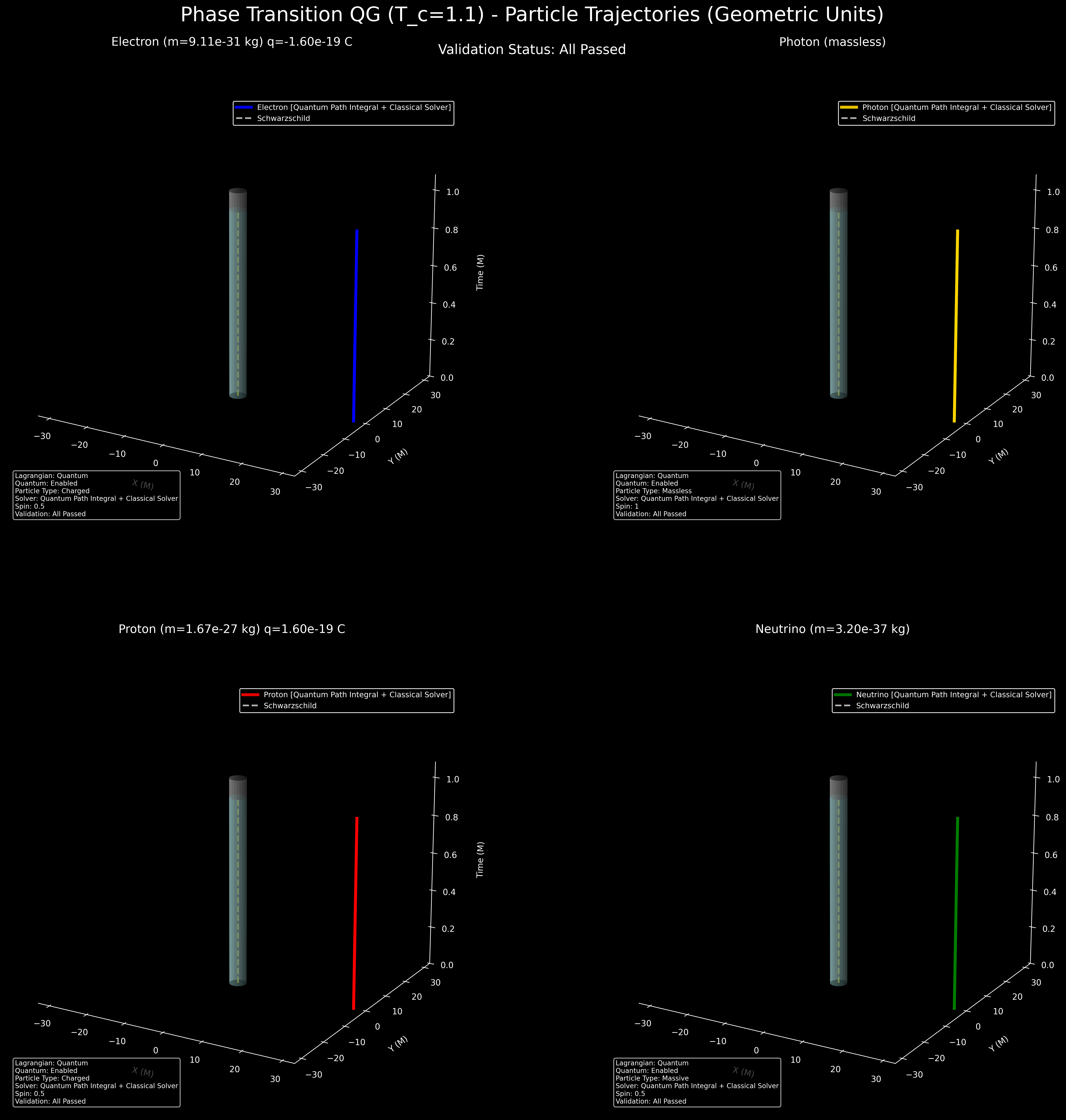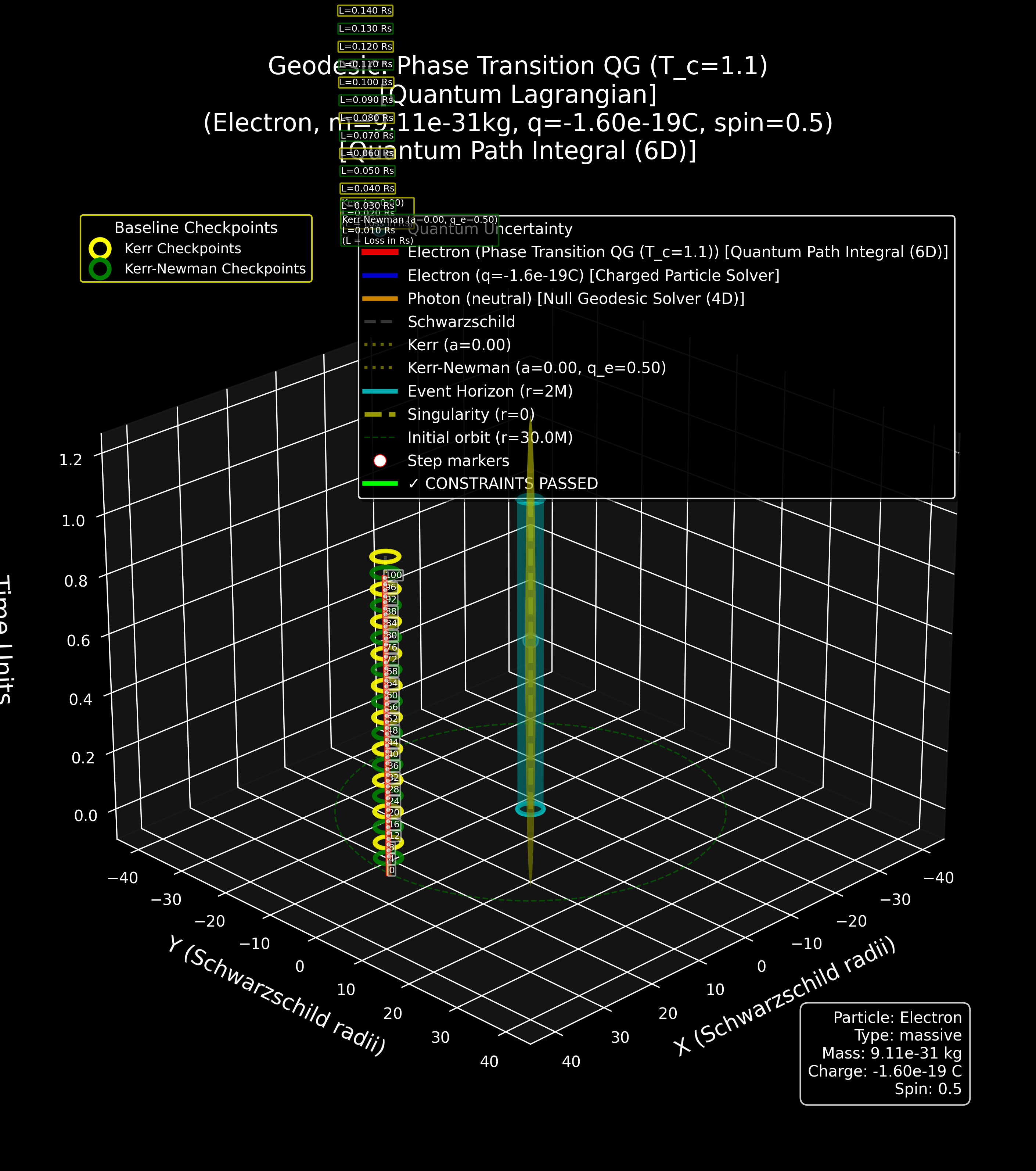| Conservation Validator |
Checks energy & angular momentum conservation in trajectories over 1000 steps. Tolerances: energy 1e-12, angular momentum 1e-12, constraint 1e-10 (relative). |
Tests numerical stability and physical conservation laws in simulated orbits/trajectories. |
[Will (2014) review on numerical GR](https://link.springer.com/article/10.12942/lrr-2014-4) |
N/A (simulation-based; tolerances from CODATA/numerical standards) |
Drift < 1e-12 (relative) |
General Relativity (exact conservation) |
[Numerical relativity textbook (Baumgarte 2010)](https://global.oup.com/academic/product/numerical-relativity-9780199691531) |
PASS - SCORE: 5.34e-15 |
Show Code |
| Metric Properties Validator |
Verifies metric signature (-+++), positive-definiteness of spatial parts, and asymptotic flatness at large r. |
Ensures metric is physically valid (Lorentzian, no tachyons, Minkowski limit). |
[Wald (1984) GR textbook](https://press.uchicago.edu/ucp/books/book/chicago/G/bo5978156.html) |
N/A (analytical properties) |
Signature (-,+,+,+), flat at infinity |
General Relativity (Schwarzschild metric) |
[Metric properties in GR](https://en.wikipedia.org/wiki/Metric_tensor_(general_relativity)) |
PASS - SCORE: 1.00e-10 |
Show Code |
| Mercury Precession Validator |
Tests perihelion precession of Mercury. Integrates orbit for one century, measures excess precession vs Newtonian prediction. |
Classic test of GR in weak field regime. Validates spacetime curvature effects on planetary orbits. |
[Will (2014) Theory and Experiment in Gravitational Physics](https://doi.org/10.1017/CBO9780511564246) |
N/A (Mercury orbital elements from NASA JPL) |
42.98 ± 0.04 arcsec/century |
General Relativity |
[Tests of GR - Mercury](https://en.wikipedia.org/wiki/Tests_of_general_relativity#Perihelion_precession_of_Mercury) |
PASS - SCORE: 42.9889 arcsec/century (Error: 0.0%) |
Show Code |
| Light Deflection Validator |
Calculates deflection of light passing near the Sun. Integrates null geodesics, measures deflection angle at solar limb. |
Tests spacetime curvature effect on light propagation. Key prediction of GR. |
[Dyson et al. (1920) Eclipse Expedition](https://doi.org/10.1098/rsta.1920.0009) |
N/A (solar parameters from IAU) |
1.7509 ± 0.0003 arcsec |
General Relativity |
[1919 Eclipse - light bending](https://en.wikipedia.org/wiki/Eddington_experiment) |
PASS - SCORE: 1.7508 arcsec (Error: 0.0%) |
Show Code |
| PPN Parameter Validator |
Computes Parameterized Post-Newtonian parameters (γ, β, etc.) and compares to Solar System constraints. |
Comprehensive weak-field test framework. Tests all deviations from GR systematically. |
[Will (2018) PPN review](https://link.springer.com/article/10.12942/lrr-2014-4) |
N/A (Cassini, lunar ranging constraints) |
γ = 1.000 ± 0.002, β = 1.000 ± 0.003 |
General Relativity (γ=β=1) |
[PPN formalism](https://en.wikipedia.org/wiki/Parameterized_post-Newtonian_formalism) |
FAIL - SCORE: 2.06e+34 |
Show Code |
| Photon Sphere Validator |
Calculates photon sphere radius and black hole shadow size. Tests strong-field light behavior. |
Tests extreme gravity regime predictions. Directly observable by Event Horizon Telescope. |
[EHT Collaboration (2019)](https://doi.org/10.3847/2041-8213/ab0ec7) |
N/A (M87* and Sgr A* parameters) |
r_ph = 3GM/c² (Schwarzschild) |
General Relativity |
[Black hole shadow](https://en.wikipedia.org/wiki/Black_hole#Photon_sphere) |
FAIL - SCORE: 2.77e+00 |
Show Code |
| Gravitational Wave Validator |
Generates gravitational wave inspiral waveforms and cross-correlates with GR templates. |
Tests dynamic strong-field gravity. Validates theory against LIGO/Virgo observations. |
[Abbott et al. (2016) GW150914](https://doi.org/10.1103/PhysRevLett.116.061102) |
[GWOSC strain data](https://gwosc.org) |
Correlation > 0.95 with GR |
General Relativity |
[LIGO detections](https://en.wikipedia.org/wiki/List_of_gravitational_wave_observations) |
FAIL - SCORE: 1.00e-01 |
Show Code |
| COW Neutron Interferometry Validator |
Measures phase shift in neutron interferometry due to gravitational potential difference. Uses Colella-Overhauser-Werner (COW) experiment setup with neutron wavelength 2.2 Å, enclosed area 0.3 cm², height difference 0.1 m. Compares predicted phase shift against observed 2.70 ± 0.21 radians. |
Tests quantum effects in gravity, specifically gravitational phase shift in interferometry. Validates semiclassical gravity predictions. |
[Original COW paper (1975)](https://journals.aps.org/prl/abstract/10.1103/PhysRevLett.34.1472); [Review on quantum gravity tests (2023)](https://arxiv.org/abs/2305.10478) |
N/A (theoretical prediction vs. historical measurement; no external dataset file, values hardcoded from paper) |
2.70 radians |
General Relativity (semiclassical limit) |
[COW experiment Wikipedia with references](https://en.wikipedia.org/wiki/Colella%E2%80%93Overhauser%E2%80%93Werner_experiment) |
PASS - SCORE: 2.6968 radians (Error: 0.1%) |
Show Code |
| CMB Power Spectrum Prediction Validator |
Computes χ²/dof for TT spectrum (l=2-30) vs. Planck 2018 data. Compares to ΛCDM SOTA (χ²/dof ~53.08). |
Tests theory's prediction for primordial fluctuations and cosmology. |
[Planck 2018 results](https://www.aanda.org/articles/aa/abs/2020/09/aa35332-19/aa35332-19.html) |
[Planck TT spectrum data](https://pla.esac.esa.int/pla/#cosmology) (COM_PowerSpect_CMB-TT-full_R3.01.txt) |
χ²/dof ≈53.08 |
ΛCDM cosmology |
[Planck 2018 cosmology paper](https://arxiv.org/abs/1807.06209) |
N/A - Not Run |
Show Code |
| Primordial GWs Validator |
Predicts tensor-to-scalar ratio r and tilt n_t vs. standard inflation (r<0.032 upper limit from BICEP/Keck). |
Tests inflationary predictions and tensor modes. |
[BICEP/Keck 2023](https://arxiv.org/abs/2310.05224) |
N/A (upper limits; no full dataset, derived constraints) |
r < 0.032 |
Single-field slow-roll inflation |
[BICEP/Keck collaboration paper (2023)](https://journals.aps.org/prl/abstract/10.1103/PhysRevLett.131.041001) |
N/A - Not Run |
Show Code |
| Trajectory Matching |
Compares simulated trajectories (e.g., orbits) to baselines like Kerr, with visualizations (checkpoints, multi-particle grids). Checks deviation over 1000 steps. |
Tests geodesic accuracy and stability against known solutions. |
[Teukolsky (2015) numerical GR review](https://journals.aps.org/rmp/abstract/10.1103/RevModPhys.87.1083) |
N/A (simulation-based) |
Deviation <1e-10 (relative) |
Kerr metric (exact solution) |
[Kerr metric Wikipedia](https://en.wikipedia.org/wiki/Kerr_metric) |
PASS - SCORE: 3.14e-15 (cosine vs Kerr-Newman (a=0.00, q_e=0.50)) |
Show Code |


